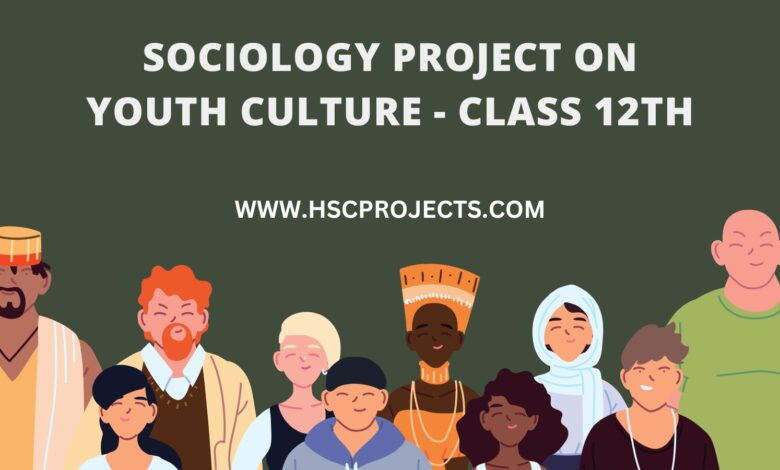
Sociology Project On Youth Culture – Class 12th
INTRODUCTION
The attitudes, beliefs, behaviours, and lifestyles of young people are referred to as youth culture, which is a distinctive social phenomena. It is the result of the interaction between historical, cultural, and social influences that mould young people’s experiences and identities in every given culture. Because it gives us insight into the experiences, viewpoints, and goals of young people as well as the larger social, economic, and political trends that influence their lives, understanding youth culture is crucial.
In recent years, sociologists, educators, legislators, and the media have all grown more interested in the topic of youth culture. The reality that young people are the future of society and that their values, attitudes, and behaviours have a big impact on societal change and growth is part of the reason behind this. Youth culture is a dynamic and multifaceted phenomena that reflects the various identities and experiences of young people as well as the ways in which they negotiate social acceptance.
This study aims to investigate the numerous facets of youth culture, including its historical, cultural, and social foundations as well as its manifestations in modern culture. By doing this, we seek to learn more about the opinions, experiences, and goals of young people as well as the larger social, economic, and political forces that influence their lives.

AN ILLUSTRATION OF YOUTH CULTURE
According to the particular social, cultural, and historical conditions in which it develops, youth culture can take on a wide variety of forms and expressions. Typical manifestations of youth culture include:
Music and fashion: Young people frequently invent and adopt new musical and fashion trends that express their preferences and philosophies. For instance, punk music emerged in the 1970s as a response to the social and economic hardships that young people faced at the time, and the movement’s style and attitude later came to represent teenage revolt and resistance.
Technology and social media: In the digital age, young people are more linked than ever thanks to these two mediums, which has given rise to fresh iterations of youth culture. Young people are continuously coming up with new methods to express themselves and interact with others, whether it is through the usage of hashtags and memes or the development of online communities.
Sports and recreation: Young people frequently engage in sports and leisure activities that align with their ideals and interests. Young people have taken to skateboarding and surfing, for instance, as ways to show their individualism and rebellious spirit and to interact with other like-minded youth.
Political and social activism: Historically, young people have been a major force in these movements, frequently speaking out in favour of progressive social change and upending the status quo. Young people have been at the vanguard of many social and political campaigns, ranging from the civil rights movement of the 1960s to the most recent global youth climate strikes.
These are just a handful of the numerous ways that youth culture can appear in society. Youth culture is a complex and dynamic representation of the experiences, attitudes, and aspirations of young people in every given society, not a homogenous or unchanging reality.
RECOGNISING YOUTH CULTURE
Complex and dynamic social phenomena, youth culture is influenced by a number of historical, cultural, social, and economic elements. Examining youth culture’s numerous facets and the ways in which they interact to influence young people’s experiences and identities is crucial for understanding it.
Historical setting: The historical setting in which youth culture develops has an impact on it. In the 1950s and 1960s, for instance, the post-World War II economic boom, which gave young people new options and cultural freedoms, had a significant impact on the birth of the baby boomer generation.
Cultural context: Because young people are frequently impacted by the values, customs, and symbols of their society, culture has a substantial impact on youth culture. For instance, the social and economic hardships of African American and Latino adolescents in inner cities, as well as the larger cultural influences of black and Latino music and fashion, contributed to the emergence of hip-hop culture in the 1980s.
Social context: As young people struggle to find their position in society and construct their identities in relation to others, social variables including class, race, gender, and sexual orientation also influence youth culture. Youth who identify as LGBTQ+, for instance, could develop their own cultural expressions and groups in response to the prejudice and marginalisation they encounter in the larger society.
Economic context: Youth culture is also influenced by economic variables like consumer culture, income inequality, and employment prospects. As a result of the little economic options and resources accessible to them, young people in low-income communities could develop their own cultural expressions and identities.
In general, to understand youth culture, one must take an interdisciplinary and intersectional approach that looks at the many variables and facets that influence young people’s experiences and identities. By doing this, we can learn more about the social, economic, and political developments that have an impact on young people’s lives and society as a whole.
CHANGES IN YOUTH CULTURE
In response to shifting social, cultural, and historical conditions, youth culture has changed and grown over time. The following are some significant turning points in youth culture history:
The 1950s: The baby boomer generation was born during the post-World War II era, a time of extraordinary economic prosperity and freedom. As a result, a distinctive youth culture that disapproved of the customs and ideals of their parents’ generation began to emerge.
The 1960s: The counterculture movement emerged during this decade and was characterised by social and political engagement, drug use and alternative lifestyles, and a distaste for conventional consumer culture. Youth culture was significantly impacted by this movement, which provided new avenues for expression and identity.
The 1970s: Punk rock began to take off in the 1970s as a reaction to the social and financial hardships that young people of the time faced. The DIY style, rebellious attitude, and rejection of established cultural conventions were traits of the punk movement.
The 1980s: Hip-hop culture, which has its roots in New York City’s African American and Latino neighbourhoods, began to gain popularity during this decade. Hip-hop culture, which was distinguished by its music, clothes, and dancing, spread throughout the world and has continued to have an impact on contemporary youth culture.
The 1990s: Grunge music first gained popularity in the 1990s, and it was distinguished by its anti-establishment stance, DIY aesthetic, and disdain for traditional consumer society. Grunge had a big influence on teenage culture, giving rise to fresh ways of expressing oneself.
The 2000s: Technology and social media advancements in the 2000s gave rise to new forms of young culture. Young people are continuously coming up with new methods to express themselves and interact with others, whether it is through the usage of hashtags and memes or the development of online communities.
All things considered, social, cultural, and historical causes have all had an impact on how youth culture has evolved. In order to acquire insight into young people’s experiences, values, and goals as well as the larger social and economic trends that influence their lives, it is crucial to understand these variables.
YOUTH CULTURE’S INFLUENCE ON MARKETING AND CONSUMER BEHAVIOR
As an important demographic for many businesses, youth culture has a tremendous impact on advertising and consumer behaviour. Youth culture has an impact on advertising and consumer behaviour in the following ways:
Branding and marketing: Youth culture frequently influences how businesses and products are marketed to and presented to young consumers. To appeal to young people’s sense of identity and culture, businesses may employ language, imagery, and music that is geared towards their generation.
Trends and fashion: Youth culture also affects beauty and fashion trends, as young people frequently set the standard for what is acceptable and fashionable. By developing items that reflect the newest trends in styles and fashion, businesses can capitalise on these trends.
Influencers and social media: Influencers and social media are becoming more crucial in determining youth culture and consumer behaviour. Young people may follow social media influencers who advertise specific goods or brands, which may have an impact on their purchase choices.
Consumption patterns: Young people may be more prone to engage in particular behaviours or activities that reflect their cultural identity, which has an impact on consumption patterns. Young people who identify with skating culture, for instance, may be more likely to buy skateboarding gear and clothing.
Impact on society: Youth culture also influences and reflects the beliefs and goals of young people, which has broader repercussions for society. It is the obligation of advertisers and businesses to be aware of these ramifications and to make sure that their marketing strategies do not support damaging stereotypes or unfavourable social trends.
Overall, youth culture has a big impact on marketing and consumer behaviour, thus businesses and marketers that want to attract young customers need to grasp these dynamics. To make sure that these practises are in line with the beliefs and aspirations of young people and society at large, it is also critical to take into account the wider social and ethical ramifications of these actions.
YOUTH CULTURE’S EFFECT ON SOCIETY AT LARGE
Since young people are frequently at the forefront of social and cultural development, youth culture has a huge impact on society as a whole. Following are some examples of how youth culture affects society:
Social and political activism: As young people use their cultural identities and expressions to promote social justice and change, youth culture frequently serves as an inspiration for social and political activism. For instance, youth-led movements like Fridays for the Future and Black Lives Matter have significantly influenced public conversation and legislation.
Cultural diversity and pluralism: Young people from many backgrounds and identities express their own viewpoints and experiences via cultural forms like music, fashion, and art, which helps to promote cultural variety and pluralism. This diversity challenges prevailing cultural norms and beliefs while enhancing society as a whole.
Consumer culture and materialism: Youth culture, on the other hand, can contribute to consumer culture and materialism since young people are more likely to be influenced by marketing and advertising. Negative societal trends like excessive consumption and environmental damage may result from this.
Technology and digital culture: Youth culture is closely related to technology and digital culture since young people are frequently early adopters of new platforms and technologies. This can promote social connectivity and creativity but can also result in problems like cyberbullying and addiction. As a result, it has both positive and negative effects on society.
Intergenerational relations: Lastly, as young people negotiate their relationships with older generations and question established power structures, youth culture has the potential to change intergenerational dynamics. Conflict may result from this, but there may also be chances for intergenerational communication and understanding.
Understanding these processes is crucial for fostering social and cultural change that is in line with the ideals and ambitions of young people and society at large. Youth culture has a complex and multifaceted impact on society.
HOW DOES CULTURE AFFECT YOUNG PEOPLE?

The growth and wellbeing of young individuals can be greatly influenced by culture. The following are some ways that culture might impact young people:
Identity formation: As young people work to comprehend and express their cultural heritage, beliefs, and traditions, culture moulds their sense of identity and belonging. Their self-esteem and general well-being may benefit from this, but if their cultural identification conflicts with dominant cultural norms or expectations, it may also cause conflict or uncertainty.
Socialization and values: Culture also has a significant impact on how young people are socialised as well as how values and conventions are passed down. Young kids pick up social skills, communication skills, and decision-making skills based on cultural expectations and beliefs. Their social and emotional development may benefit from this, but it may also help to maintain negative societal mores or norms.
Mental health and wellbeing: As young people navigate the challenges and expectations of their cultural background, culture can have an impact on their mental health and wellbeing. Cultural expectations around gender roles or academic success, for instance, might cause tension or anxiety, but cultural norms regarding mental health and asking for help can affect young people’s desire to do so.
Resources: Lastly, possibilities and access for young people to resources can be impacted by culture. Race, ethnicity, socioeconomic class, and geography are a few examples of the variables that may have an impact on this. The development and wellbeing of young people from marginalised cultural origins may be impacted by institutional hurdles that prevent them from accessing resources such as education, employment, or other opportunities.
In general, culture has a big impact on the opportunities and experiences that young people have. In order to foster a more inclusive and equitable cultural environment for all young people, it is crucial to recognise and comprehend the ways in which culture may both assist and impede their development.
REASONS TO RESEARCH YOUTH CULTURE
Youth culture research is crucial for a number of reasons. The following are some justifications on why it is crucial to comprehend youth culture:
Understanding cultural change: Youth culture can help us better comprehend the processes and trends that are reshaping our society because young people are frequently at the forefront of cultural change. This is crucial in a society that is evolving quickly and in which new technology and cultural expressions are emerging at an unprecedented rate.
Addressing social concerns: Youth culture can provide insight into the problems and issues that young people face in society, such as mental health, discrimination, and inequality. Understanding the cultural setting in which these problems occur can help us better address them and seek to build a society that is more just and equal.
Promoting intergenerational dialogue: Studying youth culture can help foster intergenerational communication and understanding because it offers a window into young people’s experiences and viewpoints. This can promote better empathy and collaboration as well as assist close the generational divide.
Enhancing policy and practice: Lastly, knowledge of young culture can improve policy and practise in sectors including social services, healthcare, and education. We may create more effective and pertinent policies and practises that better serve the needs of young people by taking into account the cultural context in which they live.
Studying youth culture is crucial for solving social concerns, comprehending cultural change, fostering intergenerational discussion, and improving policy and practise. It can help inform efforts to build a more just and equitable society and offer insightful perspectives on the lives and viewpoints of young people.
RESEARCH APPROACHES FOR EXAMINING YOUTH CULTURE
There are various research approaches that can be applied while examining youth culture. The following popular approaches may be applicable to your project:
Surveys: One popular research tool for examining youth culture is the use of surveys. They entail gathering information from a sizable sample of youth, frequently through the use of standardised questionnaires. Researchers can spot patterns and trends by using surveys to gain insightful information on young people’s beliefs, behaviours, and experiences.
Interviews: Another popular research technique for examining teenage culture is the interview. They entail having lengthy discussions with young people in either one-on-one or group settings. Interviews can give rich, in-depth insights into the experiences, viewpoints, and feelings of young people.
Observational research: Studying young people in their natural environments, such as schools, neighbourhoods, or online, is known as observational research. In-depth understanding of young people’s behaviours and relationships can be gained through observational research, which can also be particularly helpful when examining youth culture in its natural environment.
Focus groups: Focus groups include gathering a small number of teenagers to talk about a certain subject or concern. Focus groups can produce fresh ideas and solutions while also offering insightful information about the attitudes and perspectives of young people.
Case studies: A case study is a detailed examination of a specific young person or group of young people. Case studies are particularly helpful for examining unusual or exceptional cases since they can offer in-depth insights into the complicated and nuanced experiences of young people.
In general, your research question, the kind of data you need to gather, and the resources you have access to will all influence the research methodology you select. Throughout the study process, it is crucial to consider the viewpoints and experiences of young people and to use a methodology that is ethical, legitimate, and reliable.
STEP-BY-STEP INSTRUCTIONS FOR RESEARCHING YOUTH CULTURE
Identify your research question: Establishing your research question is the first step in understanding teenage culture. What facet of youth culture are you interested in studying? What are the goals of your research? Your study question needs to be narrowly defined, sociologically pertinent, and particular.
Choose your research methodology: Once your research question has been determined, you must choose your research methodology. As was previously said, a variety of research approaches, such as surveys, interviews, observational research, focus groups, and case studies, can be utilised to examine youth culture. Select the methodology that best addresses the goals and the research topic.
Create your research instrument: You must create your research instrument after selecting your study methodology. This could entail building a coding system for observational research, a discussion guide for interviews, or a questionnaire for a survey. Your research tool needs to be ethical, dependable, and valid.
Obtain your participants: After creating your research tool, you must find your subjects. You might need to select a particular sample of young people, such as high school students, college students, or young professionals, depending on your study approach. Assure all participants’ anonymity and confidentiality throughout the research process, and make sure to gain their informed consent.
Collect your data: After locating your participants, you can start gathering data. This may entail distributing your questionnaire, conducting your interviews, observing children and teenagers in their natural habitats, or leading your focus groups. Follow your research tool and approach, and be sure you accurately and systematically capture all data.
Analyze your data: After gathering your data, you must examine it. This could entail transcribing and coding interview data, categorising survey results, or utilising statistical software to analyse quantitative data. Throughout the analysis process, be sure to utilise the proper analytical techniques and to check for validity and dependability.
Interpret your results: Following data analysis, you must interpret your results. What can you infer about young culture from your findings? What repercussions does this have for theory, policy, or practise? Be sure to relate your findings to your research question and goals, and take into account any limits and alternative interpretations.
Communicate your results: When you have interpreted your results, you must then share your results. This can entail composing a research report, a presentation, or a policy brief. Be sure to identify any limitations or uncertainties in your findings and to convey your findings in a clear, succinct, and accurate manner.
Overall, careful planning, execution, and interpretation are necessary while investigating young culture. You may make sure that your research is legitimate, trustworthy, morally sound, and pertinent to the study of sociology by following a certain approach.
LIMITATIONS OF YOUTH CULTURE RESEARCH
Sample Size: The sample size is a drawback when examining youth culture. Recruiting a representative sample for your study can be challenging because of the size and diversity of the young population. The generalizability of your findings may be constrained by a small or unrepresentative sample.
Generalizability: The generalizability of your findings is yet another drawback of researching adolescent culture. What holds true for one set of young people may not hold true for others because youth culture is continuously evolving and changing. Your conclusions might only be relevant to a particular period of time, location, or set of young people.
Subjectivity: Youth culture is frequently subjective and challenging to evaluate objectively. It may be difficult, for instance, to quantify attitudes and beliefs or to pinpoint the precise cultural factors that have an impact on young people’s identity and behaviour.
Bias: The potential for bias is yet another drawback of studying teenage culture. Researchers’ personal biases or expectations about adolescent culture may have an impact on the way they conduct their studies, gather their data, and interpret their findings.
Ethical Considerations: Finally, there are various ethical questions that studying young culture presents. Participants must give their consent after being fully informed; researchers must also maintain their anonymity and confidentiality; and protect them from injury or exploitation. Additionally, when dealing with young people from marginalised or vulnerable groups, researchers must navigate the complicated power dynamics that exist between them and their subjects.
Researchers can increase the rigour, relevance, and influence of their research on youth culture by being aware of these limitations and taking action to overcome them.
DATA INTERPRETATION AND ANALYSIS
The process of studying youth culture then moves on to the analysis and interpretation of your data. You can use the following procedures to analyse and interpret your data:
Organize your data: It’s crucial to arrange your data in a way that makes sense to you before you start to analyse it. This could entail writing up your interview transcripts, categorising the results of your survey, or making a spreadsheet to keep track of your observations.
Clean up your data: After organising your data, you should “clean” it by looking for mistakes, missing information, or outliers. By doing this, you can increase the accuracy and dependability of your findings.
Pick your analytical strategies: You may use a variety of analytical strategies to analyse your data, depending on your research topic and methodology. These could consist of discourse analysis, content analysis, statistical analysis, or thematic analysis.
Analyze your data: You can start analysing your data once you’ve decided on your analysis methods. This might entail computing descriptive statistics, spotting themes or patterns, or looking at how different variables interact.
Interpret your results: After you’ve examined your data, it’s crucial to explain your conclusions. This entails interpreting the patterns or relationships you’ve found and coming to judgements about their significance. Be sure to link your conclusions to your research question and goals.
Evaluate the validity and reliability of your findings: Assess the validity and reliability of your findings: It’s crucial to assess the validity and reliability of your findings at every stage of the analysis and interpretation process. This can entail searching for alternate theories, taking into account the constraints of your data, or assessing the generalizability of your conclusions.
Report your findings: Following the analysis and interpretation of your data, you must provide your conclusions. This can entail composing a research report, a presentation, or a policy brief. Be sure to convey your findings in an ethical, precise, and unambiguous manner.
By taking these actions, you may make sure that your research on youth culture is valid, trustworthy, and pertinent to the sociology profession.
CONCLUSION
In conclusion, research on young culture is a significant field in sociology. Youth culture is defined as the attitudes, values, behaviours, and beliefs of young people. A variety of elements, such as the media, peers, families, and socioeconomic status, influence youth culture.
We can create more effective policies and initiatives to support young people if we have a greater grasp of youth culture. By doing so, we can better comprehend the experiences, viewpoints, and issues that young people confront.
In this research, we have looked at the idea of youth culture, how it has changed through time, how it affects young people, and how it affects society as a whole. We have also looked at the ways in which culture can influence youth as well as the research approaches utilised to investigate youth culture.
We can better understand the experiences and viewpoints of young people and create more effective policies and initiatives to support them by analysing and interpreting data on youth culture. Studying youth culture does have its limitations, though, such as those relating to sample size, generalizability, subjectivity, bias, and ethical problems.
Overall, studying adolescent culture is intricate and multifaceted, necessitating an interdisciplinary, nuanced approach. We can learn more about the opinions and experiences of young people by investigating this issue further, which will help us build a society that is more inclusive and equal.
Certificate of Completion
[Your Name][Your Class/Grade][Date]This is to certify that I, [Your Name], a student of Class 12th, have successfully completed the project on “Youth Culture” as a part of my sociology course. The project aimed to explore the attitudes, beliefs, behaviors, and lifestyles of young people and their impact on society.
I undertook this project to gain a deeper understanding of the diverse aspects of youth culture, including its historical, cultural, and social foundations, as well as its manifestations in modern society. Through extensive research and analysis, I aimed to investigate the opinions, experiences, and goals of young people, along with the broader social, economic, and political forces that influence their lives.
The project highlighted various forms of youth culture, such as music and fashion, technology and social media, sports and recreation, and political and social activism. It also shed light on the influence of youth culture on marketing and consumer behavior, as well as its wider impact on society at large.
Throughout the research process, I utilized various research approaches, including surveys, interviews, observational research, and data analysis, to gather insightful information about youth culture. I made every effort to ensure the validity and reliability of the data collected and adhered to ethical considerations in my research.
The journey of exploring youth culture has been an enlightening and enriching experience. I have gained valuable knowledge about the dynamic and complex nature of youth culture and its significance in shaping the future of society.
I would like to express my gratitude to my teacher for guiding and supporting me throughout the project. Their valuable insights and encouragement have been instrumental in the successful completion of this endeavor.
I hereby present this project with the hope that it contributes to a better understanding of youth culture and its implications for society. It has been an honor to undertake this study, and I believe that it will serve as a meaningful contribution to the field of sociology.
Signature: ________
Your Name
In order to download the PDF, You must follow on Youtube. Once done, Click on Submit
Follow On YoutubeSubscribed? Click on Confirm
Download Sociology Project On Youth Culture – Class 12th PDF






